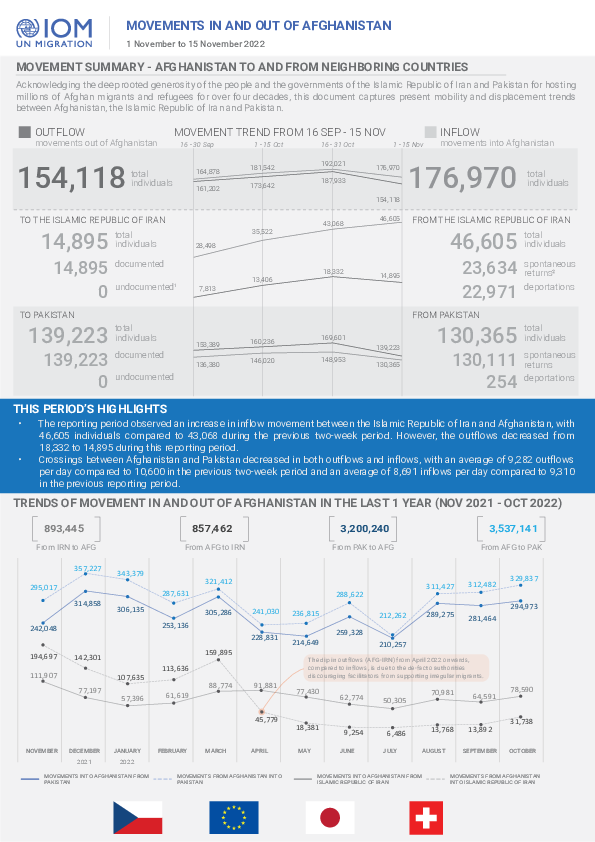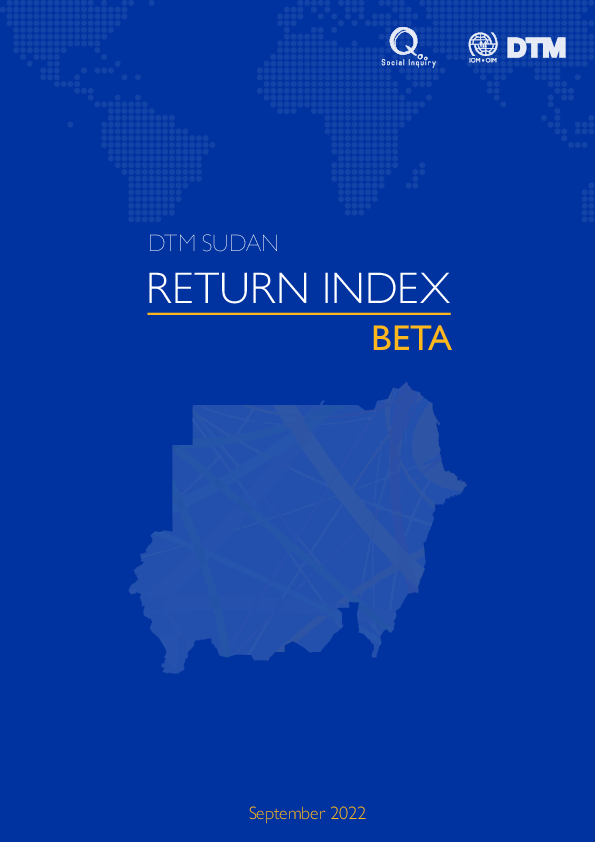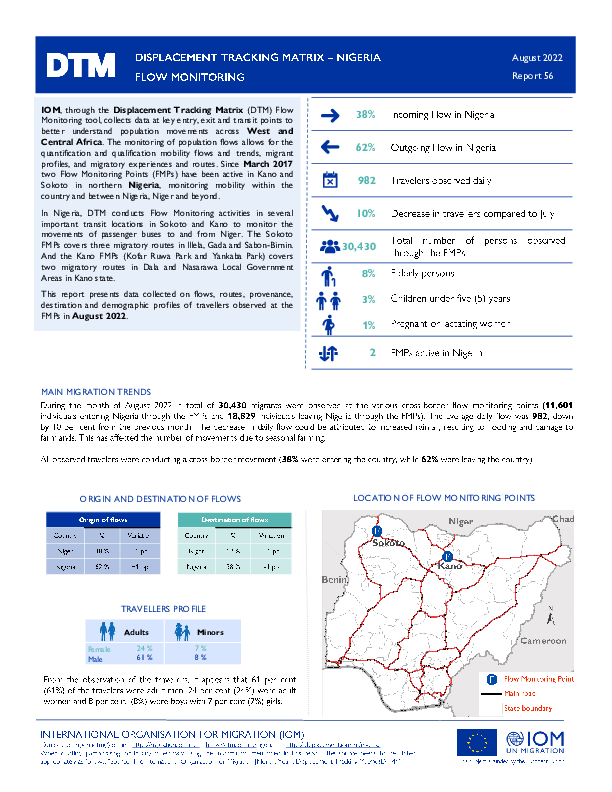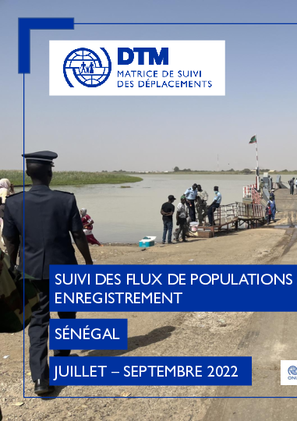-
Countries
-
Data and Analysis
-
Special Focus
-
Crisis Responses

Contact
DTMAfghanistan@iom.int
Language
English
Location
Afghanistan
Period Covered
Nov 01 2022
Nov 15 2022
Activity
- Flow Monitoring
The snapshot captures present mobility and displacement trends between Afghanistan, the Islamic Republic of Iran and Pakistan.

Contact
dtmsudan@iom.int
Language
English
Location
Sudan
Period Covered
Dec 15 2021
Jan 16 2022
Activity
- Return Intention
- Mobility Tracking
To address a gap in information on the conditions in which permanent returnees are living across Sudan, which makes difficult to understand why IDPs return to some areas and not others or, put another way, what makes some locations more conducive to voluntary return than others, IOM DTM designed the first ever (beta version) Return Index for Sudan.
Sudan Return Index Beta evaluates the material and social living conditions in locations of return in Sudan based on a common and comparable value. This tool shows that locations with better conditions are also more conducive to having returnee populations. The Return Index can be used to infer what conditions are most critical for facilitating returns, how to address obstacles, where to geographically target interventions and advocacy, how to strategize for resources and operations, and to explore changes in conditions over time.
The tool provides a means of measuring the severity of living conditions in locations of returns by combining first, a collection of context informed minimum or critical living conditions that are necessary to make a location adequate enough to sustain returning populations; and second, quantitative analysis to generate and apply an index score to each location based on the state of these indicators.

Contact
DTM Nigeria, AllUsersInDTMNigeria@iom.int
Language
English
Location
Nigeria
Period Covered
Aug 01 2022
Aug 31 2022
Activity
- Flow Monitoring
In Nigeria, DTM conducts Flow Monitoring activities in several important transit locations in Sokoto and Kano to monitor the movements of passenger buses to and from Niger. The Sokoto FMPs covers three migratory routes in Illela, Gada and Sabon-Birnin. And the Kano FMPs (Kofar Ruwa Park and Yankaba Park) covers two migratory routes in Dala and Nasarawa Local Government Areas in Kano state. This report presents data collected on flows, routes, provenance, destination and demographic profiles of travellers observed at the FMPs in August 2022.
During the month of August 2022, a total of 30,430 migrants were observed at the various cross-border flow monitoring points (11,601 individuals entering Nigeria through the FMPs and 18,829 individuals leaving Nigeria through the FMPs). The average daily flow was 982, down by 10 per cent from the previous month. The decrease in daily flow could be attributed to increased rainfall, resulting to flooding and damage to farmlands. This has affected the number of movements due to seasonal farming. All observed travelers were conducting a cross-border movement (38% were entering the country, while 62% were leaving the country).

Contact
DTM Mali, DTMMali@iom.int
Language
English
Location
Mali
Period Covered
Oct 01 2022
Oct 31 2022
Activity
- Flow Monitoring
In order to gain a better understanding of mobility flows and trends, the International Organization for Migration (IOM) has implemented the Displacement Tracking Matrix’s Flow Monitoring (FM) tool at key transit points across the region. Flow Monitoring activities are conducted in close cooperation with national and local authorities as well as local partners. The Flow Monitoring tool consists of two main components: the Flow Monitoring Registry (FMR), which captures key data on the volume, origin, destination and mode of travel of mobility flows, and the Flow Monitoring Survey (FMS), individual surveys conducted with travellers to gather detailed information about the profiles, migration experience and intentions of migrants. Through these activities, the Flow Monitoring tool collects data on migration flows and trends, traveller profiles, migration journeys, and intentions of migrants, so as to obtain a better understanding of mobility.
In Mali, DTM conducts Flow Monitoring activities at seven Flow Monitoring Points (FMPs) located across six regions, in order to foster a better understanding of the numbers, trends, profiles, and journeys of migration flows crossing these points.
This reports presents data collected through the Flow Monitoring Registry in October 2022.

Contact
DTM Mali, DTMMali@iom.int
Language
French
Location
Mali
Period Covered
Oct 01 2022
Oct 30 2022
Activity
- Flow Monitoring
Afin de mieux comprendre les mouvements et tendances migratoires, l’OIM, à travers la Matrice de suivi des déplacements (Displacement Tracking Matrix, DTM), met en œuvre l’activité de Suivi des flux de populations (Flow Monitoring, FM).
Le suivi des flux, qui est mis en œuvre en étroite collaboration avec les autorités et des partenaires nationaux et locaux, est composé de deux outils: l’enregistrement des flux (Flow Monitoring Registry, FMR), qui recueille des données clés sur l’ampleur, la provenance, la destination et les modalités des flux de mobilité, et les enquêtes individuelles (Flow Monitoring Survey, FMS), conduites auprès des voyageurs afin d’obtenir des informations sur les profils, parcours migratoires, et intentions des migrants. Le suivi des flux de populations récolte ainsi des données sur les flux et tendances migratoires, les profils des voyageurs et les parcours et intentions des migrants, afin de fournir une meilleure compréhension des mobilités.
Au Mali, la DTM recueille des données au niveau de 7 Points de suivi des flux (Flow Monitoring Points, FMP), répartis dans 6 régions afin d’obtenir une meilleure compréhension de l’ampleur, des tendances, des caractéristiques socio-démographiques et des parcours des flux de voyageurs traversant ces différents points.
Ce rapport présente les données recueillies dans le cadre des activités d’enregistrement des flux durant le mois de octobre 2022.

Contact
Regional Office Dakar, RODakarepcteam@iom.int
Language
French
Location
Senegal
Period Covered
Jul 01 2022
Sep 30 2022
Activity
- Flow Monitoring
Afin de mieux comprendre les mouvements et tendances migratoires en Afrique de l’Ouest et du Centre, l’OIM, à travers la Matrice de suivi des déplacements (Displacement Tracking Matrix, DTM), met en œuvre l’activité de Suivi des flux de populations (Flow Monitoring, FM).
Le suivi des flux, qui est mis en œuvre en étroite collaboration avec les autorités et des partenaires nationaux et locaux, est composé de deux outils : l’enregistrement des flux (Flow Monitoring Registry, FMR), qui recueille des données clés sur l’ampleur, la provenance, la destination et les modalités des flux, et les enquêtes individuelles (Flow Monitoring Survey, FMS), conduites auprès des voyageurs afin d’obtenir des informations sur les profils, les parcours migratoires et les intentions des migrants. Le suivi des flux de populations récolte ainsi des données clés sur les flux et les tendances migratoires, les profils des voyageurs, les parcours et intentions des migrants, afin de fournir une meilleure compréhension des mobilités en Afrique de l’Ouest et du Centre.
Au Sénégal, depuis 2017, plusieurs points de suivi des flux de populations (FMP) ont été progressivement installés dans d'importantes localités du Sénégal pour faire le suivi des flux migratoires dans le pays récolter des données sur les tendances de mobilité, les profils et les parcours des voyageurs dans le pays.
Après un arrêt des activités entre avril 2021 et mai 2022 marqué par la fermeture des points existants, la collecte de données a repris avec l’ouverture d'un nouveau site à Rosso (Sénégal), permettant de faire le suivi des dynamiques migratoires depuis le nord du Sénégal, zone de passage de la route méditerranéenne occidentale, et des mouvements entre le Sénégal et la Mauritanie.
Ce rapport présente les données collectées pendant le deuxième trimestre de l’année 2022 (juillet à septembre 2022), au niveau du seul FMP actifs au Sénégal.

Contact
rodakar-dataresearch@iom.int
Language
English
Location
The Gambia
Period Covered
Jul 01 2022
Sep 30 2022
Activity
- Survey
- Flow Monitoring Survey
In order to gain a better understanding of mobility flows and trends throughout West and Central Africa, the International Organization for Migration (IOM) implements the Displacement Tracking Matrix’s Flow Monitoring (FM) tool at key transit points across the region.
Flow Monitoring activities are conducted in close cooperation with national and local authorities as well as with local partners. The Flow Monitoring tool consists of two main components: the Flow Monitoring Registry (FMR), which captures key data on the magnitude, origin, destination and mode of travel of mobility flows, and the Flow Monitoring Survey (FMS), for which individual surveys are conducted with travellers to gather detailed information about the profiles, migration experience and intentions of migrants. Through these activities, the Flow Monitoring tool collects data on migration flows and trends, traveller profiles, migration journeys and intentions of migrants in order to obtain a deeper view of mobility in West and Central Africa.
In The Gambia, DTM conducts Flow Monitoring activities at several important transit locations: in 1) Barra (FMPs are located at the ferry terminal and the main garage);
2) Farafenni (FMPs are located at Farafenni main garage, Farafenni Ballan-Ghar garage, Farafenni McCarthy and Sanjally garage, Farafenni turntable garage and the truck garage); 3) Basse (FMPs are situated at the main garage and the bus station in Basse Santa-Su) and 4) Brikama (FMPs are located at the main garage and the Bus station).
This activities enable DTM to monitor the movements of passenger within The Gambia, out of and towards The Gambia as well as transiting The Gambia.
This report presents the key results from the Flow Monitoring Survey conducted with travellers between July to September 2022. The report presents data collected on flows, routes, provenance, destination and demographic profiles of travellers observed at the FMPs.
Additional information on Flow Monitoring methodology is available on the last page.
Contact
DTMMali@iom.int
Location
Mali
Activity
- Mobility Tracking
- Baseline Assessment
Period Covered
Aug 01 2022 -Aug 31 2022
A baseline assessment is a sub-component of mobility tracking. It aims to collect data on IDP, migrant or returnee population presence in a defined administrative area of the country.
Population Groups
Survey Methodology
Unit of Analysis Or Observation
Type of Survey or Assessment
Keywords
Geographical Scope
Administrative boundaries with available data
The current dataset covers the following administrative boundaries

Contact
DTM Somalia, IOMSomaliaDTM@iom.int
Language
English
Location
Somalia
Period Covered
Oct 15 2022
Oct 31 2022
Activity
- Flow Monitoring
A total of 13,007 movements were observed between the 15th and 31st of October, 2022, representing a similar trend to 2021 when 14,207 movements were observed during the same period. Regional differences were observed. If compared with October 2021, Elayo (90%), Dhobley (31%) and Harirad (14%) FMPs recorded an increase in movements; while Cabudwaaq (-86%), Lowyacado (-36%), Buuhoodle (-13%), Doolow (-11%) and Bossasso (-5%) FMPs observed a decrease. Buuhoodle (30%), Dhobley (26%) and Doolow (23%) FMPs recorded the highest numbers of incoming flows, while Bossaso (36%), Doolow (39%) and Elayo (13%) recorded the highest numbers of outgoing flows.
Contact
DTM Libya, DTMLibya@iom.int
Language
English
Location
Libya
Snapshot Date
Oct 31 2022
Activity
- Mobility Tracking
- Site Assessment
Detention Centre Profiling is a component of IOM Libya’s Displacement Matrix programme. It is a data oriented tool that routinely provides specific sex and age demographic data and key sectorial information on individuals held in Libya’s detention centres on the date of assessment.